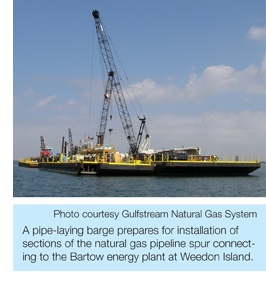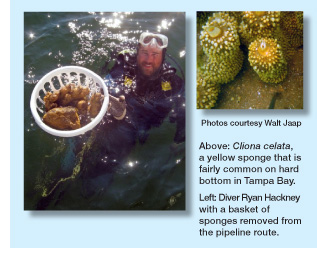 |
||||||||
Pipeline Extension Brings Natural Gas
to Bartow Plant
By Mary Kelley Hoppe
 When Progress Energy decided to convert its Bartow plant on Weedon Island from oil to natural gas, it hired Gulfstream Natural Gas to construct a 17.5-mile spur connecting to Gulfstream’s mainline, which stretches 691 miles from Alabama to Port Manatee.
When Progress Energy decided to convert its Bartow plant on Weedon Island from oil to natural gas, it hired Gulfstream Natural Gas to construct a 17.5-mile spur connecting to Gulfstream’s mainline, which stretches 691 miles from Alabama to Port Manatee.
Expected to be complete in October, the $156-million pipeline took more than 100 workers, 10 barges and nearly seven months to finish. Additional compression facilities, or pumping stations, will be built in Manatee County and Coden, Alabama to support the expanded service.
Crews working aboard shallow-water barges used directional drills to install the underground pipes at five points where the pipeline crosses the shipping channel. The technology enabled Gulfstream to avoid environmentally sensitive areas and cross the channels without interrupting ship traffic, while burying pipe at depths of up to 91 feet. The remainder of the pipeline was buried at depths of at least three feet in a mechanically excavated pipe trench that was backfilled after the pipe was laid. Each 40-foot section of pipe weighs 15 tons.
Planning for the project began more than two years ago when Gulfstream examined a 1000-foot-wide corridor in Tampa Bay for hard bottoms, submerged aquatic vegetation, archeological points of interest and potential construction hazards. Information generated from these surveys helped Gulfstream identify environmentally sensitive areas to be avoided in planning the pipeline route.
To mitigate for unavoidable construction impacts to hard bottom colonies in the bay, Gulfstream was required to establish nearly three acres of similar or better habitat at several sites located in the middle of the bay west of the pipeline. The company also will be mitigating for impacts resulting from “frack-outs” occurring last Spring and Summer, when drilling mud escaped near Weedon Island, impacting two acres of seagrass beds. The sediment was promptly vacuumed out using special equipment and hauled off by barge.
“We went out to look at it (after the cleanup), and we were surprisingly pleased about how healthy the seagrasses were,” said Pam Leasure, an environmental program manager with Pinellas County.
Air, Water Quality Improvements Expected
Re-powering the plant on Weedon Island will allow the utility to more than double its generating capacity while slashing emissions of sulfur dioxide, nitrogen oxides and particulates by as much as 85% from existing levels. Of that, NOx emissions are expected to drop by about 21%, or 852 tons per year.
Besides improving air quality, that’s good news for Tampa Bay. Emissions from power plants and automobiles are a major source of nitrogen to the bay. Stationary sources such as power plants and garbage incinerators contribute about 66% of the NOx released to the air in the Tampa Bay watershed; mobile sources such as cars and boats make up the balance.
Excess nitrogen fuels the growth of algae, which block sunlight from reaching seagrasses. As the algae die and decay, they consume oxygen that other sealife needs to survive.
The Bartow Plant conversion is the latest in a series of power plant improvements that are expected to help the region take major steps in achieving water quality goals for Tampa Bay. In Hillsborough County, Tampa Electric Company (TECO) has completed the first phase in a series of mandated pollution-control improvements by converting its Gannon power station from coal to natural gas. The company also is installing Selective Catalytic Reduction (SCR) equipment at its Big Bend power station to further reduce NOx emissions.
In 1994, TECO’s Gannon and Big Bend plants accounted for about two-thirds, or nearly 120,450 tons per year, of total NOX emissions for Tampa Bay. By 2011, the utility’s annual contribution is expected to be less than 10%.
When completed, TECO power plant improvements may lower the amount of nitrogen entering the bay in air emissions by approximately 12 tons per year. The Tampa Bay Estuary Program’s nitrogen management strategy calls for reducing nitrogen from all sources by 17 tons per year to keep pace with continued growth and associated increases in pollution.
Stricter Air Quality Standards Will Force Further Action
Despite these improvements, tougher federal air quality standards enacted this year are likely to force local governments to take additional measures to curb emissions. In May, the Environmental Protection Agency announced its most stringent eight-hour standard ever for ozone, a major component of smog. The new ozone measure is .075 parts per million, down from .08 ppm.
EPA based its decision – the first ozone standard revision in more than a decade -— on increasing scientific evidence about the harmful effects of ozone pollution, which causes respiratory problems, particularly for people suffering from asthma.
“We were marginally meeting the old standard,” says Jerry Campbell, air quality director for the Hillsborough County Environmental Protection Commission. “In any three-year period, we may go in and out of compliance.”
The same is true for other counties, which will need to work together to devise regional solutions to the problem. EPA will designate non-attainment areas in 2010. State action plans are due by 2013, with attainment dates ranging from 2013 to 2030 depending on the severity of the problem.
Last year, Florida became the 12th state to adopt California’s stricter vehicle emissions standards, as part of an overall strategy to reduce greenhouse emissions. While the move could be sufficient to bring many non-attainment areas into compliance, EPA struck down California’s request for a waiver to let the state enforce auto emissions that are tougher than federal law. Florida is among the states joining California in a lawsuit to overturn the decision.
 Reef Relief: Coral and Sponge Harvest Jumpstarts Mitigation
Reef Relief: Coral and Sponge Harvest Jumpstarts Mitigation
Six months after deploying 6,200 tons of limestone boulders and transplanting 5,000 plants to three sites west of the main shipping channel in middle Tampa Bay, mangrove snapper and other fish are busy darting around a manmade coral reef. To compensate for unavoidable impacts to hard-bottom habitat in construction of its natural gas pipeline, Gulfstream Natural Gas was required to establish 2.83 acres of similar or better habitat. The operation began with two major transplants. First, divers collected sponges and octocorals from the mitigation area in preparation for seeding the sandy bottom with limestone rock hauled in by barge. Next, they collected plants in the path of the pipeline corridor. Harvested plants were loaded into baskets and transported by boat to an underwater holding area until the limestone boulders could be deployed. In all, 5,000 corals, sponges and seawhips were transplanted to three new reefs. Smaller plants were affixed to the limestone relief using a special epoxy. Larger sponges were wedged in between the rocks to reattach to the hard surface. “These plants are pretty resilient and tolerant,” said Walt Jaap of Lithophyte Research, which assisted with one of the sponge harvesting operations.
Early success of a similar effort in 2001, during construction of the Gulfstream mainline, prompted company officials to recommend the same approach for the Phase IV mitigation. Surveys of the Phase 1 mitigation areas indicate that recovery has been reached well ahead of schedule. Fish and plant recruitment at the mitigation sites are essentially comparable to reference sites.
